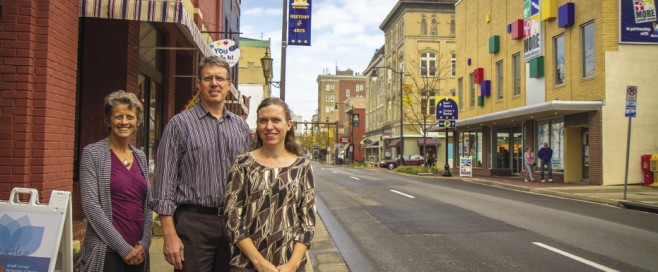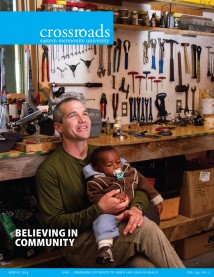
Alumni at the Fairfield Center (from left): Sue Praill, MA ’10 (conflict transformation), directs its restorative justice programs; Tim Ruebke ’92, MA ’99 (conflict transformation) is its executive director; and Shannon Sneary ’93 oversees its training services. (Photo by Jon Styer)
Harrisonburg’s Fairfield Center – known for most of its 32-year history as the Community Mediation Center – has a long record of leadership in promoting and practicing creative problem-solving in Virginia. Founded as an alternative to the court system for mediating disputes in the community, the Fairfield Center (the name used throughout this story for consistency’s sake) took its first case in February 1982.
Ever since, mediation has remained a central focus of the organization. Executive director Tim Ruebke ’92, MA ’99 (conflict transformation), estimates that more than 10,000 cases have been mediated at the Fairfield Center. Thousands of people have been trained to do mediation, seeding conflict-handling skills far and wide in the community.
“Our mission is to help people interact and listen more effectively … so that what they’re facing can be transformed in a positive way,” says Ruebke.
From the very beginning, the center has had close ties to EMU. Some of the founding board members – including Barry Hart, MDiv ’78, Kathryn Fairfield ’70, and David Kreider ’76, MA ’78 (religion), MA ’09 (conflict transformation) – first got their heads together after a 1981 conference at EMU on alternatives to incarceration. They were further inspired the following year when Ron Kraybill, then the director of the Mennonite Conciliation Service and later a professor at EMU’s Center for Justice and Peacebuilding from 1995 to 2005, gave a lecture on mediation in Staunton.
When the center opened in 1982, it was the first mediation-focused program in the state. Hart was the center’s first official director; Sue Hess Yoder ’72 and Margaret Jantzi Foth, class of ’54, also were directors in the late ’80s and early ’90s. Numerous students and alumni have worked, interned or volunteered for the center.
During its first two decades, the Fairfield Center trained and supported many of the other mediation centers that now exist in Virginia. It also began a long-running peer mediator program in local schools and was instrumental – particularly through the work of founding board member and local attorney Larry Hoover – in the establishment of a dispute resolution office at the Supreme Court of Virginia. Hoover’s work also led to the addition of mediation principles to the state bar’s official code of conduct manual.
To keep up with evolving needs in and around Harrisonburg, and to maintain its financial viability (as worthwhile as they are, mediations alone don’t generate enough revenue to sustain a thriving organization), the Fairfield Center now offers services in five areas: conflict resolution, restorative justice, training, civic engagement and business services.
Over the past five years, the Fairfield Center has pursued its civic engagement mission by sponsoring about 20 community dialogues around issues like sustainability, intercultural and interfaith relations, and local economies. In the spring of 2013, it sponsored a dialogue on guns and security and hosted a community conversation on mental health. Intended to promote thoughtful, productive discussion among people with differing views on the issues, the recent dialogues have been hosted in partnership with the Kettering Foundation and James Madison University’s Institute for Constructive Advocacy and Dialogue.
“We see our role in the community as being a place to reclaim good public ways to talk with your neighbors and to create better community,” says Ruebke. “Wherever we can increase listening and improve how people interact with one another around issues, problems and conflicts, we see us having a role.”
Another ongoing initiative, led by Sue Praill, MA ’10 (conflict transformation), the center’s director of restorative justice, is the development of a restorative justice partnership with the Harrisonburg Police Department. She hopes this will eventually result in local police referring certain types of crimes – perhaps vandalism or minor theft – for resolution through a restorative justice process rather than through the legal system.
“We have a very dynamic task force in place, and we’re working on getting things started,” says Praill, who has had productive discussions about the idea with the city’s police chief.
She also leads a “victim sensitization” program at the Harrisonburg Men’s Diversion Center, a state corrections facility. Many of the men who participate tell Praill after they complete the program, taught in six two-hour sessions, that they have a new understanding of the ways that crimes, even minor ones, hurt victims.
Shannon Sneary ’93 oversees Fairfield’s training services. These include sessions for people pursuing state certification as mediators (overseen by the very division of the Supreme Court that the center had a role in creating) and other programs designed for organizations and businesses to improve their communications and effectiveness.
One of Sneary’s current goals is to expand its Spanish-language training program, in the hope of eventually offering more mediation services conducted entirely in Spanish. The Fairfield Center now has one bilingual certified mediator, giving it some ability to mediate for Spanish-speaking clients.
That growing need for Spanish mediation is a reflection of changing demographics in Harrisonburg, now one of the most diverse cities in the state with more than 14% of its residents born in other countries.
International festival
Since 2010, the Fairfield Center has also served as the institutional home of the Harrisonburg International Festival, first held in 1997. The festival’s co-chair is David Kreider, one of the founders of the Fairfield Center who is again sitting on its board. The 16th annual festival, in the fall of 2013, was the largest ever, with nearly 9,000 people attending.
Kreider notes that the influx of refugees to Harrisonburg has often brought people from opposing sides of conflicts elsewhere in the world. And while the festival’s primary intention is simply to celebrate the different traditions represented in Harrisonburg, the practices of dialogue, conflict resolution and restorative justice espoused by the Fairfield Center have been important along the way in improving how these different communities coexist in their new home.
“While it has been difficult, it has also been very rewarding to feel we have had a part in helping understanding, connection, and healing to begin to happen,” Kreider says – illustrating one of the ways in which the Fairfield Center’s original mission is being applied today in Harrisonburg, to situations the organization’s founders wouldn’t have anticipated more than 30 years ago.
— Andrew Jenner ’04
